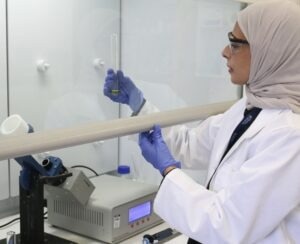Researchers from Flinders University's Nanotechnology Department collaborated with international scientists to develop the size and shape of gold nanoparticles from different VFD processing parameters and concentrations of gold chloride solution, as published in a recent article in Small Science.
 Ph.D. candidate Badriah Alotaibi with a gold chloride solution and the vortex fluidic device used in the research experiments. Image Credit: Flinders University
Ph.D. candidate Badriah Alotaibi with a gold chloride solution and the vortex fluidic device used in the research experiments. Image Credit: Flinders University
Researchers made this startling discovery by modifying the water flow in the innovative vortex fluidic device. They created a variety of distinct kinds of gold nanoparticles without the use of hazardous chemicals.
The discovery of a contact electrification reaction in the device’s water, which produced hydrogen and hydrogen peroxide, resulted from the green chemistry lab work on the creation of nanogold.
Through this research, we have discovered a new phenomenon in the vortex fluidic device. The photo-contact electrificiation process at the solid-liquid interface which could be used in other chemical and biological reactions.
Ms Badriah Alotaibi Ph.D., Study Lead, Flinders University
Alotaibi continued, “We also have achieved synthesis of pure, pristine gold nanoparticles in water in the VFD, without the use of chemicals commonly used – and thus minimizing waste. This method is significant for the formation of nanomaterials in general because it is a green process, quick, scalable, and yields nanoparticles with new properties.”
Various applications, including drug delivery, catalysis, sensing, and electronics, depend on the size and shape of gold nanoparticles because of their unique physical, chemical, and optical characteristics.
The vortex fluidic device, developed 10 years ago by Colin Raston, a Professor at Flinders University and senior author, consists of a quickly rotating tube that is open at one end and uses jet feeds to deliver liquids. Particles can be synthesized to specifications using the device by applying light externally and rotating at different speeds.
Researchers around the world are now finding the continuous flow, thin film fluidic device useful in exploring and optimizing more sustainable nano-scale processing techniques. In this latest experiment, we hypothesize that the high shear regimes of the VFD led to the quantum mechanical effect known as contact electrification, which is another exciting development.
Colin Raston, Professor and Study Senior Author, Flinders University
Professor Raston said, “This discovery is a paradigm shift in how to make materials in a controlled way using water, with no other chemicals required, which contributes to a more sustainable future.”
The Australian National Fabrication Facility (ANFF), the Australian Microscopy and Microanalysis Research Facility (AMMRF), the College of Science and Engineering mechanical workshop at Flinders University, and the Australia Research Council funded the study.
Immiscible Liquids - Green Chemistry Solutions
Video Credit: Flinders University.
Journal Reference:
Alotaibi, M. B., et al. (2024) Nanogold Foundry Involving High‐Shear‐Mediated Photo contact Electrification in Water. Small Science. doi.org/10.1002/smsc.202300312.